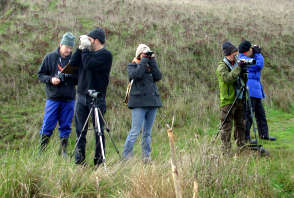 Bay Area birders participate in the Audubon Christmas Bird
Bay Area birders participate in the Audubon Christmas Bird
Count. Credit: terriem on flickr.com
Though it's easy to forget, any kid with a magnifying glass can tell you that you don't need a fancy degree to be a scientist. All it takes is a curious mind and a keen eye for observation. And in case the mere thought of a world full of wonders isn't enough to get you motivated, there are dozens of ways your personal observations can contribute to formal, published research. It's called "citizen science".
The idea behind citizen science is that ordinary folks, spread all across the country (or the world!), can collect valuable data on a breadth and scale that would be impossible for a single researcher to do on her own. It's particularly suited to projects that require lots of field observations but not a lot of special tools – things like counting creatures or measuring snow. And while the Internet has made the process of recruiting volunteers and reporting data easier than ever, for most projects, no technology is necessary. One of the oldest citizen science projects, the Audubon Society's Christmas Bird Count, has been happening for over a hundred years!
In case you have any doubts about whether a scattered group of untrained citizens can really produce valuable data, just check out this week's headlines about how climate change is affecting bird populations (they're moving north). The news is based on an Audubon Society study that looked at 40 years worth of citizen-produced information.
So how can you get involved? There are all kinds of projects, some that are ongoing, others that happen at a particular time. Here are a few to consider:
- From February 13th – 16th, 2009, you can participate in the 12th annual Great Backyard Bird Count, another Audubon Society project (in partnership with the Cornell Lab of Ornithology), either on your own or by joining up with the Sacramento Audubon Society's organized events.
- As fellow blogger Ben Burress reported last month, from March 16-28, 2009 you can monitor light pollution through Globe At Night.
- Track a plant through the seasons with Project Budburst.
- Visit AntWeb's Bay Area Ant Survey to find out how to help discover and document the native and invasive ants in the Bay Area.
- Monitor frogs in your area with Frogwatch USA.
- Keep track of the weather with the Community Collaborative Rain, Hail, & Snow Network.
- Follow the Monarch butterfly migrations with a variety of projects.
There's so much science out there, just waiting for you to get involved. Go observe!
